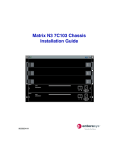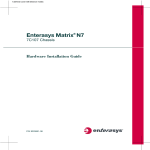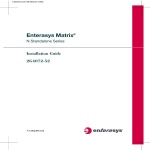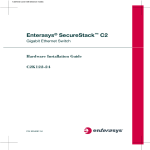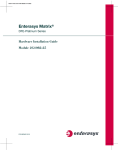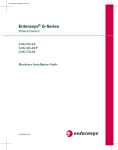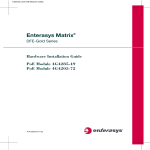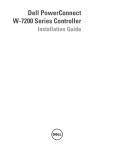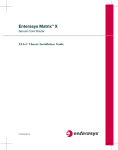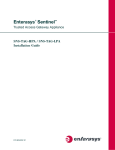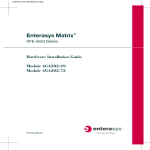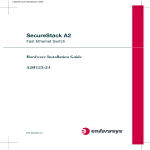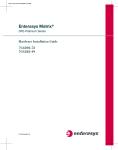Download Enterasys Matrix N3 Installation guide
Transcript
7.5x9-inch cover with bleed on 4 sides Enterasys Matrix® N3 7C103 Chassis Hardware Installation Guide P/N 9033824-06 Electrical Hazard: Only qualified personnel should perform installation procedures. Riesgo Electrico: Solamente personal calificado debe realizar procedimientos de instalacion. Elektrischer Gefahrenhinweis: Installationen sollten nur durch ausgebildetes und qualifiziertes Personal vorgenommen werden. Notice Enterasys Networks reserves the right to make changes in specifications and other information contained in this document and its web site without prior notice. The reader should in all cases consult Enterasys Networks to determine whether any such changes have been made. The hardware, firmware, or software described in this document is subject to change without notice. IN NO EVENT SHALL ENTERASYS NETWORKS BE LIABLE FOR ANY INCIDENTAL, INDIRECT, SPECIAL, OR CONSEQUENTIAL DAMAGES WHATSOEVER (INCLUDING BUT NOT LIMITED TO LOST PROFITS) ARISING OUT OF OR RELATED TO THIS DOCUMENT, WEB SITE, OR THE INFORMATION CONTAINED IN THEM, EVEN IF ENTERASYS NETWORKS HAS BEEN ADVISED OF, KNEW OF, OR SHOULD HAVE KNOWN OF, THE POSSIBILITY OF SUCH DAMAGES. Enterasys Networks, Inc. 50 Minuteman Road Andover, MA 01810 © 2008 Enterasys Networks, Inc. All rights reserved. Part Number: 9033824‐06 July 2008 ENTERASYS, ENTERASYS NETWORKS, ENTERASYS MATRIX, ENTERASYS NETSIGHT, LANVIEW, WEBVIEW, and any logos associated therewith, are trademarks or registered trademarks of Enterasys Networks, Inc., in the United States and other countries. All other product names mentioned in this manual may be trademarks or registered trademarks of their respective companies. Documentation URL: http://www.enterasys.com/support/manuals Documentacion URL: http://www.enterasys.com/support/manuals Dokumentation im Internet: http://www.enterasys.com/support/manuals i Regulatory Compliance Information Federal Communications Commission (FCC) Notice This device complies with Part 15 of the FCC rules. Operation is subject to the following two conditions: (1) this device may not cause harmful interference, and (2) this device must accept any interference received, including interference that may cause undesired operation. NOTE: This equipment has been tested and found to comply with the limits for a class A digital device, pursuant to Part 15 of the FCC rules. These limits are designed to provide reasonable protection against harmful interference when the equipment is operated in a commercial environment. This equipment uses, generates, and can radiate radio frequency energy and if not installed in accordance with the operator’s manual, may cause harmful interference to radio communications. Operation of this equipment in a residential area is likely to cause interference in which case the user will be required to correct the interference at his own expense. WARNING: Changes or modifications made to this device which are not expressly approved by the party responsible for compliance could void the user’s authority to operate the equipment. Industry Canada Notice This digital apparatus does not exceed the class A limits for radio noise emissions from digital apparatus set out in the Radio Interference Regulations of the Canadian Department of Communications. Le présent appareil numérique n’émet pas de bruits radioélectriques dépassant les limites applicables aux appareils numériques de la class A prescrites dans le Règlement sur le brouillage radioélectrique édicté par le ministère des Communications du Canada. Class A ITE Notice WARNING: This is a Class A product. In a domestic environment this product may cause radio interference in which case the user may be required to take adequate measures. Clase A. Aviso de ITE ADVERTENCIA: Este es un producto de Clase A. En un ambiente doméstico este producto puede causar interferencia de radio en cuyo caso puede ser requerido tomar medidas adecuadas. Klasse A ITE Anmerkung WARNHINWEIS: Dieses Produkt zählt zur Klasse A ( Industriebereich ). In Wohnbereichen kann es hierdurch zu Funkstörungen kommen, daher sollten angemessene Vorkehrungen zum Schutz getroffen werden. Product Safety This product complies with the following: UL 60950, CSA C22.2 No. 60950, 2006/95/EC, EN 60950, IEC 60950, EN 60825, 21 CFR 1040.10. Seguridad del Producto El producto de Enterasys cumple con lo siguiente: UL 60950, CSA C22.2 No. 60950, 2006/95/EC, EN 60950, IEC 60950, EN 60825, 21 CFR 1040.10. Produktsicherheit Dieses Produkt entspricht den folgenden Richtlinien: UL 60950, CSA C22.2 No. 60950, 2006/95/EC, EN 60950, IEC 60950, EN 60825, 21 CFR 1040.10. ii Electromagnetic Compatibility (EMC) This product complies with the following: 47 CFR Parts 2 and 15, CSA C108.8, 2004/108/EC, EN 55022, EN 61000‐3‐2, EN 61000‐3‐3, EN 55024, AS/NZS CISPR 22, VCCI V‐3. Compatibilidad Electromágnetica (EMC) Este producto de Enterasys cumple con lo siguiente: 47 CFR Partes 2 y 15, CSA C108.8, 2004/108/EC, EN 55022, EN 55024, EN 61000‐3‐2, EN 61000‐3‐3, AS/NZS CISPR 22, VCCI V‐3. Elektro- magnetische Kompatibilität ( EMC ) Dieses Produkt entspricht den folgenden Richtlinien: 47 CFR Parts 2 and 15, CSA C108.8, 2004/108/EC, EN 55022, EN 61000‐3‐2, EN 61000‐3‐3, EN 55024, AS/NZS CISPR 22, VCCI V‐3. Hazardous Substances This product complies with the requirements of European Directive, 2002/95/EC, Restriction of Hazardous Substances (RoHS) in Electrical and Electronic Equipment. European Waste Electrical and Electronic Equipment (WEEE) Notice In accordance with Directive 2002/96/EC of the European Parliament on waste electrical and electronic equipment (WEEE): 1. The symbol above indicates that separate collection of electrical and electronic equipment is required and that this product was placed on the European market after August 13, 2005, the date of enforcement for Directive 2002/96/EC. 2. When this product has reached the end of its serviceable life, it cannot be disposed of as unsorted municipal waste. It must be collected and treated separately. 3. It has been determined by the European Parliament that there are potential negative effects on the environment and human health as a result of the presence of hazardous substances in electrical and electronic equipment. 4. It is the users’ responsibility to utilize the available collection system to ensure WEEE is properly treated. For information about the available collection system, please go to www.enterasys.com/support/ or contact Enterasys Customer Support at 353 61 705586 (Ireland). iii ѻક䇈ᯢк䰘ӊ Supplement to Product Instructions 䚼ӊৡ⿄ (Parts) 䞥ሲ䚼ӊ (Metal Parts) ⬉䏃ഫ (Circuit Modules) ⬉㓚ঞ⬉㓚㒘ӊ (Cables & Cable Assemblies) ล᭭㘮ড়⠽䚼ӊ (Plastic and Polymeric parts) ⬉䏃ᓔ݇ (Circuit Breakers) ƻ˖ 䪙 3E ᳝↦᳝ᆇ⠽䋼ܗ㋴(Hazardous Substance) ⒈㘨㣃 ∲ 䬝 ݁Ӌ䫀 3%% +J &G &U ⒈Ѡ㣃䝮 3%'( h ƻ ƻ h ƻ ƻ h ƻ ƻ h ƻ ƻ h ƻ ƻ h ƻ ƻ ƻ ƻ ƻ ƻ ƻ h ƻ ƻ h h ƻ ƻ 㸼⼎䆹᳝↦᳝ᆇ⠽䋼䆹䚼ӊ᠔᳝ഛ䋼ᴤ᭭Ёⱘ䞣ഛ SJ/T 11363-2006 ᷛޚ㾘ᅮⱘ䰤䞣㽕∖ҹϟDŽ Indicates that the concentration of the hazardous substance in all homogeneous materials in the parts is below the relevant threshold of the SJ/T 11363-2006 standard. h˖ 㸼⼎䆹᳝↦᳝ᆇ⠽䋼㟇ᇥ䆹䚼ӊⱘᶤϔഛ䋼ᴤ᭭Ёⱘ䞣䍙ߎSJ/T 11363-2006 ᷛޚ㾘ᅮⱘ䰤䞣㽕∖DŽ Indicates that the concentration of the hazardous substance of at least one of all homogeneous materials in the parts is above the relevant threshold of the SJ/T 11363-2006 standard. ᇍ䫔ଂП᮹ⱘ᠔ଂѻકᴀ㸼ᰒ⼎ ߃߯կᑨ䫒ⱘ⬉ᄤֵᙃѻકৃ㛑ࣙ䖭ѯ⠽䋼DŽ⊼ᛣ᠔ଂѻકЁৃ㛑Ӯгৃ㛑ϡӮ᳝᠔᳝᠔߫ⱘ䚼ӊDŽ This table shows where these substances may be found in the supply chain of Enterasys’ electronic information products, as of the date of sale of the enclosed product. Note that some of the component types listed above may or may not be a part of the enclosed product. 䰸䴲⡍߿ⱘᷛ⊼ℸᷛᖫЎ䩜ᇍ᠔⍝ঞѻકⱘ⦃ֱՓ⫼ᳳᷛᖫᶤѯ䳊䚼ӊӮ ᳝ϔϾϡৠⱘ⦃ֱՓ⫼ᳳ՟བ⬉∴ऩܗഫ䌈݊ѻકϞ ℸ⦃ֱՓ⫼ᳳ䰤া䗖⫼ѢѻકᰃѻકݠЁ᠔㾘ᅮⱘᴵӊϟᎹ The Environmentally Friendly Use Period (EFUP) for all enclosed products and their parts are per the symbol shown here, unless otherwise marked. Certain parts may have a different EFUP (for example, battery modules) and so are marked to reflect such. The Environmentally Friendly Use Period is valid only when the product is operated under the conditions defined in the product manual. iv 50 VCCI Notice This is a class A product based on the standard of the Voluntary Control Council for Interference by Information Technology Equipment (VCCI). If this equipment is used in a domestic environment, radio disturbance may arise. When such trouble occurs, the user may be required to take corrective actions. BSMI EMC Statement — Taiwan This is a class A product. In a domestic environment this product may cause radio interference in which case the user may be required to take adequate measures. Safety Information Class 1 Laser Transceivers The single mode interface modules use Class 1 laser transceivers. Read the following safety information before installing or operating these modules. The Class 1 laser transceivers use an optical feedback loop to maintain Class 1 operation limits. This control loop eliminates the need for maintenance checks or adjustments. The output is factory set, and does not allow any user adjustment. Class 1 Laser transceivers comply with the following safety standards: • 21 CFR 1040.10 and 1040.11 U.S. Department of Health and Human Services (FDA). • IEC Publication 825 (International Electrotechnical Commission). • CENELEC EN 60825 (European Committee for Electrotechnical Standardization). When operating within their performance limitations, laser transceiver output meets the Class 1 accessible emission limit of all three standards. Class 1 levels of laser radiation are not considered hazardous. When the connector is in place, all laser radiation remains within the fiber. The maximum amount of radiant power exiting the fiber (under normal conditions) is ‐12.6 dBm or 55 x 10‐6 watts. Removing the optical connector from the transceiver allows laser radiation to emit directly from the optical port. The maximum radiance from the optical port (under worst case conditions) is 0.8 W cm‐2 or 8 x 103 W m2 sr‐1. Do not use optical instruments to view the laser output. The use of optical instruments to view laser output increases eye hazard. When viewing the output optical port, power must be removed from the network adapter. v Declaration of Conformity Application of Council Directive(s): Manufacturer’s Name: Manufacturer’s Address: European Representative Address: Conformance to Directive(s)/Product Standards: Equipment Type/Environment: 2004/108/EC 2006/95/EC Enterasys Networks, Inc. 50 Minuteman Road Andover, MA 01810 USA Enterasys Networks, Ltd. Nexus House, Newbury Business Park London Road, Newbury Berkshire RG14 2PZ, England EC Directive 2004/108/EC EN 55022 EN 61000‐3‐2 EN 61000‐3‐3 EN 55024 EC Directive 2006/95/EC EN 60950 EN 60825 Networking Equipment, for use in a Commercial or Light Industrial Environment. Enterasys Networks, Inc. declares that the equipment packaged with this notice conforms to the above directives. vi ENTERASYS NETWORKS, INC. FIRMWARE LICENSE AGREEMENT BEFORE OPENING OR UTILIZING THE ENCLOSED PRODUCT, CAREFULLY READ THIS LICENSE AGREEMENT. This document is an agreement (“Agreement”) between the end user (“You”) and Enterasys Networks, Inc., on behalf of itself and its Affiliates (as hereinafter defined) (“Enterasys”) that sets forth Your rights and obligations with respect to the Enterasys software program/firmware (including any accompanying documentation, hardware or media) (“Program”) in the package and prevails over any additional, conflicting or inconsistent terms and conditions appearing on any purchase order or other document submitted by You. “Affiliate” means any person, partnership, corporation, limited liability company, other form of enterprise that directly or indirectly through one or more intermediaries, controls, or is controlled by, or is under common control with the party specified. This Agreement constitutes the entire understanding between the parties, with respect to the subject matter of this Agreement. The Program may be contained in firmware, chips or other media. BY INSTALLING OR OTHERWISE USING THE PROGRAM, YOU REPRESENT THAT YOU ARE AUTHORIZED TO ACCEPT THESE TERMS ON BEHALF OF THE END USER (IF THE END USER IS AN ENTITY ON WHOSE BEHALF YOU ARE AUTHORIZED TO ACT, “YOU” AND “YOUR” SHALL BE DEEMED TO REFER TO SUCH ENTITY) AND THAT YOU AGREE THAT YOU ARE BOUND BY THE TERMS OF THIS AGREEMENT, WHICH INCLUDES, AMONG OTHER PROVISIONS, THE LICENSE, THE DISCLAIMER OF WARRANTY AND THE LIMITATION OF LIABILITY. IF YOU DO NOT AGREE TO THE TERMS OF THIS AGREEMENT OR ARE NOT AUTHORIZED TO ENTER INTO THIS AGREEMENT, ENTERASYS IS UNWILLING TO LICENSE THE PROGRAM TO YOU AND YOU AGREE TO RETURN THE UNOPENED PRODUCT TO ENTERASYS OR YOUR DEALER, IF ANY, WITHIN TEN (10) DAYS FOLLOWING THE DATE OF RECEIPT FOR A FULL REFUND. IF YOU HAVE ANY QUESTIONS ABOUT THIS AGREEMENT, CONTACT ENTERASYS NETWORKS, LEGAL DEPARTMENT AT (978) 684‐1000. You and Enterasys agree as follows: 1. LICENSE. You have the non‐exclusive and non‐transferable right to use only the one (1) copy of the Program provided in this package subject to the terms and conditions of this Agreement. 2. RESTRICTIONS. Except as otherwise authorized in writing by Enterasys, You may not, nor may You permit any third party to: (a) Reverse engineer, decompile, disassemble or modify the Program, in whole or in part, including for reasons of error correction or interoperability, except to the extent expressly permitted by applicable law and to the extent the parties shall not be permitted by that applicable law, such rights are expressly excluded. Information necessary to achieve interoperability or correct errors is available from Enterasys upon request and upon payment of Enterasys’ applicable fee. (b) Incorporate the Program in whole or in part, in any other product or create derivative works based on the Program, in whole or in part. (c) Publish, disclose, copy reproduce or transmit the Program, in whole or in part. (d) Assign, sell, license, sublicense, rent, lease, encumber by way of security interest, pledge or otherwise transfer the Program, in whole or in part. (e) Remove any copyright, trademark, proprietary rights, disclaimer or warning notice included on or embedded in any part of the Program. 3. APPLICABLE LAW. This Agreement shall be interpreted and governed under the laws and in the state and federal courts of the Commonwealth of Massachusetts without regard to its conflicts of laws provisions. You accept the personal jurisdiction and venue of the Commonwealth of Massachusetts courts. None of the 1980 United Nations Convention on the Limitation Period in the International Sale of Goods, and the Uniform Computer Information Transactions Act shall apply to this Agreement. vii 4. EXPORT RESTRICTIONS. You understand that Enterasys and its Affiliates are subject to regulation by agencies of the U.S. Government, including the U.S. Department of Commerce, which prohibit export or diversion of certain technical products to certain countries, unless a license to export the product is obtained from the U.S. Government or an exception from obtaining such license may be relied upon by the exporting party. If the Program is exported from the United States pursuant to the License Exception CIV under the U.S. Export Administration Regulations, You agree that You are a civil end user of the Program and agree that You will use the Program for civil end uses only and not for military purposes. If the Program is exported from the United States pursuant to the License Exception TSR under the U.S. Export Administration Regulations, in addition to the restriction on transfer set forth in Section 1 or 2 of this Agreement, You agree not to (i) reexport or release the Program, the source code for the Program or technology to a national of a country in Country Groups D:1 or E:2 (Albania, Armenia, Azerbaijan, Belarus, Cambodia, Cuba, Georgia, Iraq, Kazakhstan, Laos, Libya, Macau, Moldova, Mongolia, North Korea, the People’s Republic of China, Russia, Tajikistan, Turkmenistan, Ukraine, Uzbekistan, Vietnam, or such other countries as may be designated by the United States Government), (ii) export to Country Groups D:1 or E:2 (as defined herein) the direct product of the Program or the technology, if such foreign produced direct product is subject to national security controls as identified on the U.S. Commerce Control List, or (iii) if the direct product of the technology is a complete plant or any major component of a plant, export to Country Groups D:1 or E:2 the direct product of the plant or a major component thereof, if such foreign produced direct product is subject to national security controls as identified on the U.S. Commerce Control List or is subject to State Department controls under the U.S. Munitions List. 5. UNITED STATES GOVERNMENT RESTRICTED RIGHTS. The enclosed Program (i) was developed solely at private expense; (ii) contains “restricted computer software” submitted with restricted rights in accordance with section 52.227‐19 (a) through (d) of the Commercial Computer Software‐Restricted Rights Clause and its successors, and (iii) in all respects is proprietary data belonging to Enterasys and/or its suppliers. For Department of Defense units, the Program is considered commercial computer software in accordance with DFARS section 227.7202‐3 and its successors, and use, duplication, or disclosure by the U.S. Government is subject to restrictions set forth herein. 6. DISCLAIMER OF WARRANTY. EXCEPT FOR THOSE WARRANTIES EXPRESSLY PROVIDED TO YOU IN WRITING BY ENTERASYS, ENTERASYS DISCLAIMS ALL WARRANTIES, EITHER EXPRESS OR IMPLIED, INCLUDING BUT NOT LIMITED TO IMPLIED WARRANTIES OF MERCHANTABILITY, SATISFACTORY QUALITY, FITNESS FOR A PARTICULAR PURPOSE, TITLE AND NON‐INFRINGEMENT WITH RESPECT TO THE PROGRAM. IF IMPLIED WARRANTIES MAY NOT BE DISCLAIMED BY APPLICABLE LAW, THEN ANY IMPLIED WARRANTIES ARE LIMITED IN DURATION TO THIRTY (30) DAYS AFTER DELIVERY OF THE PROGRAM TO YOU. 7. LIMITATION OF LIABILITY. IN NO EVENT SHALL ENTERASYS OR ITS SUPPLIERS BE LIABLE FOR ANY DAMAGES WHATSOEVER (INCLUDING, WITHOUT LIMITATION, DAMAGES FOR LOSS OF BUSINESS, PROFITS, BUSINESS INTERRUPTION, LOSS OF BUSINESS INFORMATION, SPECIAL, INCIDENTAL, CONSEQUENTIAL, OR RELIANCE DAMAGES, OR OTHER LOSS) ARISING OUT OF THE USE OR INABILITY TO USE THE PROGRAM, EVEN IF ENTERASYS HAS BEEN ADVISED OF THE POSSIBILITY OF SUCH DAMAGES. THIS FOREGOING LIMITATION SHALL APPLY REGARDLESS OF THE CAUSE OF ACTION UNDER WHICH DAMAGES ARE SOUGHT. THE CUMULATIVE LIABILITY OF ENTERASYS TO YOU FOR ALL CLAIMS RELATING TO THE PROGRAM, IN CONTRACT, TORT OR OTHERWISE, SHALL NOT EXCEED THE TOTAL AMOUNT OF FEES PAID TO ENTERASYS BY YOU FOR THE RIGHTS GRANTED HEREIN. viii 8. AUDIT RIGHTS. You hereby acknowledge that the intellectual property rights associated with the Program are of critical value to Enterasys, and, accordingly, You hereby agree to maintain complete books, records and accounts showing (i) license fees due and paid, and (ii) the use, copying and deployment of the Program. You also grant to Enterasys and its authorized representatives, upon reasonable notice, the right to audit and examine during Your normal business hours, Your books, records, accounts and hardware devices upon which the Program may be deployed to verify compliance with this Agreement, including the verification of the license fees due and paid Enterasys and the use, copying and deployment of the Program. Enterasys’ right of examination shall be exercised reasonably, in good faith and in a manner calculated to not unreasonably interfere with Your business. In the event such audit discovers non‐compliance with this Agreement, including copies of the Program made, used or deployed in breach of this Agreement, You shall promptly pay to Enterasys the appropriate license fees. Enterasys reserves the right, to be exercised in its sole discretion and without prior notice, to terminate this license, effective immediately, for failure to comply with this Agreement. Upon any such termination, You shall immediately cease all use of the Program and shall return to Enterasys the Program and all copies of the Program. 9. OWNERSHIP. This is a license agreement and not an agreement for sale. You acknowledge and agree that the Program constitutes trade secrets and/or copyrighted material of Enterasys and/or its suppliers. You agree to implement reasonable security measures to protect such trade secrets and copyrighted material. All right, title and interest in and to the Program shall remain with Enterasys and/or its suppliers. All rights not specifically granted to You shall be reserved to Enterasys. 10. ENFORCEMENT. You acknowledge and agree that any breach of Sections 2, 4, or 9 of this Agreement by You may cause Enterasys irreparable damage for which recovery of money damages would be inadequate, and that Enterasys may be entitled to seek timely injunctive relief to protect Enterasys’ rights under this Agreement in addition to any and all remedies available at law. 11. ASSIGNMENT. You may not assign, transfer or sublicense this Agreement or any of Your rights or obligations under this Agreement, except that You may assign this Agreement to any person or entity which acquires substantially all of Your stock assets. Enterasys may assign this Agreement in its sole discretion. This Agreement shall be binding upon and inure to the benefit of the parties, their legal representatives, permitted transferees, successors and assigns as permitted by this Agreement. Any attempted assignment, transfer or sublicense in violation of the terms of this Agreement shall be void and a breach of this Agreement. 12. WAIVER. A waiver by Enterasys of a breach of any of the terms and conditions of this Agreement must be in writing and will not be construed as a waiver of any subsequent breach of such term or condition. Enterasys’ failure to enforce a term upon Your breach of such term shall not be construed as a waiver of Your breach or prevent enforcement on any other occasion. 13. SEVERABILITY. In the event any provision of this Agreement is found to be invalid, illegal or unenforceable, the validity, legality and enforceability of any of the remaining provisions shall not in any way be affected or impaired thereby, and that provision shall be reformed, construed and enforced to the maximum extent permissible. Any such invalidity, illegality, or unenforceability in any jurisdiction shall not invalidate or render illegal or unenforceable such provision in any other jurisdiction. 14. TERMINATION. Enterasys may terminate this Agreement immediately upon Your breach of any of the terms and conditions of this Agreement. Upon any such termination, You shall immediately cease all use of the Program and shall return to Enterasys the Program and all copies of the Program. ix x Contents ABOUT THIS GUIDE Who Should Use This Guide......................................................................................... xiii Structure of This Guide ................................................................................................. xiii Using the Enterasys Matrix Series Manual Set.............................................................xiv Document Conventions..................................................................................................xv 1 INTRODUCTION 1.1 1.2 1.3 2 INSTALLATION REQUIREMENTS AND GUIDELINES 2.1 2.2 2.3 3 Installation Site Guidelines.............................................................................. 2-1 Configuration Guidelines................................................................................. 2-2 LANVIEW LEDs .............................................................................................. 2-3 2.3.1 Power Supply LEDs ........................................................................ 2-3 2.3.2 Fan Status LED............................................................................... 2-4 CHASSIS SETUP 3.1 3.2 3.3 3.4 A Overview ......................................................................................................... 1-1 Features .......................................................................................................... 1-2 Getting Help .................................................................................................... 1-5 Unpacking the Chassis ................................................................................... 3-1 Setting Up the Chassis.................................................................................... 3-2 3.2.1 Order of Installation......................................................................... 3-2 3.2.2 Installing the Rubber Feet............................................................... 3-2 3.2.3 Rack Mounting the Chassis ............................................................ 3-4 3.2.4 Attaching the Electrostatic Discharge Wrist Strap .......................... 3-5 3.2.5 Installing a Power Supply................................................................ 3-6 3.2.6 Removing a Power Supply.............................................................. 3-8 Powering Up the Chassis.............................................................................. 3-10 Removing and Reinstalling the Fan Tray ...................................................... 3-11 3.4.1 Removing the Fan Tray ................................................................ 3-11 3.4.2 Reinstalling the Fan Tray .............................................................. 3-13 SPECIFICATIONS AND REGULATORY COMPLIANCE Contents xi Figures 1-1 2-1 2-2 3-1 3-2 3-3 3-4 3-5 3-6 3-7 The Matrix N3 7C103 Chassis with Redundant Power Supplies .................................... 1-2 7C203-1 Power Supply LEDs.......................................................................................... 2-3 Fan Status LED on Chassis Front Panel......................................................................... 2-4 Chassis Bottom, Rubber Feet Placement ....................................................................... 3-3 Rack Mounting the Chassis............................................................................................. 3-5 ESD Grounding Receptacle ............................................................................................ 3-5 Installing the Power Supply Module(s) ............................................................................ 3-7 Removing a Power Supply from a Powered Up Chassis ................................................ 3-9 Connecting the Power Supply AC Power Cord ............................................................. 3-10 Removing the Fan Tray................................................................................................. 3-12 Tables 2-1 2-2 xii Power Supply (PS) LED Status Definitions ..................................................................... 2-4 Fan Status LED States and Their Definitions.................................................................. 2-4 Contents About This Guide This guide lists features and options of the Enterasys Matrix® N3 7C103 chassis and explains how to install the power supplies and remove and reinstall the fan tray. WHO SHOULD USE THIS GUIDE Electrical Hazard: Only qualified personnel should perform installation procedures. Riesgo Electrico: Solamente personal calificado debe realizar procedimientos de instalacion. Elektrischer Gefahrenhinweis: Installationen sollten nur durch ausgebildetes und qualifiziertes Personal vorgenommen werden. This guide is intended for a network administrator responsible for installing and setting up the N3 chassis. A general working knowledge of data communications networks is helpful when setting up the N3 chassis. Read through this guide completely to familiarize yourself with its contents and to gain an understanding of the features and capabilities of the N3 chassis. Note: In this guide, the Enterasys Matrix® N3 7C103 chassis is also referred to as the N3 chassis or simply, the chassis. STRUCTURE OF THIS GUIDE This guide is organized as follows: This preface provides preliminary information to help you use this guide and a brief summary of each chapter. It also discusses the Enterasys Matrix Series manual set and defines conventions used throughout this document. Chapter 1, Introduction, describes the features and capabilities of the chassis, and how to get help, if needed. Chapter 2, Installation Requirements and Guidelines, lists the installation site requirements that must be met before installing the chassis in a cabinet or rack. This chapter also includes configuration guidelines, and operating specifications for the chassis enclosure and power supply modules. About This Guide xiii Using the Enterasys Matrix Series Manual Set Chapter 3, Chassis Setup, contains instructions for installing the chassis as a standalone or rack-mounted unit, installing and removing the power supply modules, removing and reinstalling the fan tray, and powering up the chassis. Appendix A, Specifications and Regulatory Compliance, lists environmental and operating specifications for the chassis, power supply modules, and the fan tray. USING THE ENTERASYS MATRIX SERIES MANUAL SET Separate manuals have been developed for the DFE modules that can be installed in the 7C103 chassis. These manuals explain how to install the DFE modules, attach cable segments to the modules, and configure the modules using a command line interface to manage the system after the installation of the chassis and modules is complete. The specifications for the modules are included in their respective manual. Each manual in this set assumes that the qualified personnel installing the module has a general working knowledge of data communications networks and their physical layer components. Note: You can view and download all product documentation from the Enterasys web site: http://www.enterasys.com/support/manuals Nota: Puedes ver y bajar toda la documentacion de productos del sitio Web de Enterasys Networks en la siguiente liga: http://www.enterasys.com/support/manuals Anmerkung: Jegliche Produktdokumentationen finden sie zur Ansicht oder zum „Download“ unter: http://www.enterasys.com/support/manuals xiv About This Guide Document Conventions DOCUMENT CONVENTIONS This guide uses the following conventions: Note: Calls the reader’s attention to any item of information that may be of special importance. Caution: Contains information essential to avoid damage to the equipment. Precaución: Contiene información esencial para prevenir dañar el equipo. Achtung: Verweißt auf wichtige Informationen zum Schutz gegen Beschädigungen. Electrical Hazard: Warns against an action that could result in personal injury or death due to an electrical hazard. Riesgo Electrico: Advierte contra una acción que pudiera resultar en lesión corporal o la muerte debido a un riesgo eléctrico. Elektrischer Gefahrenhinweis: Warnung vor sämtlichen Handlungen, die zu Verletzung von Personen oder Todesfällen – hervorgerufen durch elektrische Spannung – führen können! Warning: Warns against an action that could result in personal injury or death. Advertencia: Advierte contra una acción que pudiera resultar en lesión corporal o la muerte. Warnhinweis: Warnung vor Handlungen, die zu Verletzung von Personen oder gar Todesfällen führen können! About This Guide xv Document Conventions xvi About This Guide 1 Introduction This chapter provides an overview of the Matrix N3 7C103 Chassis and its features. Also covered in this chapter are the instructions on how to obtain additional help from Enterasys Networks™ if needed. 1.1 OVERVIEW The N3 chassis provides three slots that can contain a variety of modules. The chassis backplane supports a new generation of advanced switching modules (7Hxxxx and 7Gxxxx series). The N3 chassis • • • • uses a distributed switching architecture, allows hot swapping of the modules, and fan assembly, supports redundant power supplies, and can be installed as a freestanding chassis or installed into a standard 48.26-centimeter (19-inch) rack, occupying only 36 centimeters (14 inches) of vertical rack space. The power supplies and modules are installed from the front of the chassis for ease of maintenance. Removal and re-installation of the fan assembly is from the rear of the chassis. All LED indicators are observable from the front of the chassis to aid in monitoring network operational status and performing maintenance. Figure 1-1 illustrates the chassis equipped with three modules and two 7C203-1 redundant power supplies. Introduction 1-1 Features Figure 1-1 The Matrix N3 7C103 Chassis with Redundant Power Supplies  FAN STATUS Á 7C203-1 PWR REDUNDANCY 0 À 100-125V~12.0A 200-240V~6.0A 50/60 Hz 7C203-1 PWR REDUNDANCY 0 1 Two slots for 7C203-1 power supplies 1.2 2 Three slots for 7Hxxxx and 7Gxxxx series modules 100-125V~12.0A 200-240V~6.0A 50/60 Hz 3 Fan Tray located at the rear of the chassis FEATURES The following provides an overview of the chassis features. Matrix N3 7C103 Chassis Modules The N3 chassis has three slots that support 7Hxxxx and 7Gxxxx series modules. This provides the flexibility to configure the chassis with modules available to support 10/100/1000 Ethernet and Gigabit Ethernet to WAN and ATM applications. 1-2 Introduction Features Redundant Power Supplies The N3 chassis supports up to two 7C203-1 power supplies in the lower two slots of the chassis labeled PS1 and PS2. One power supply provides sufficient power for a chassis that is fully loaded with modules. However, a second power supply may be installed to provide redundancy and load sharing. When two power supplies are installed, each power supply is capable of load sharing 50% (+/- 5%) of the total power required by the chassis. This not only provides redundancy, it also extends the life of the power supplies. If one power supply fails, the other power supply supports the entire power load of the chassis without interruption to network traffic. Refer to Section 2.1 for power outlet requirements. Power Supply LANVIEW® LEDs Each power supply comes equipped with LANVIEW LEDs for at-a-glance diagnostics that indicate individual power supply status and overall chassis redundancy status. Refer to Chapter 2, Installation Requirements and Guidelines, for a full explanation of the power supply LEDs and their definitions. Power Supply Status via Management The 7C203-1 power supplies report information to the modules installed in the chassis regarding their present operating status as well as the fan tray status. This information includes the following: • Power Supply ID (PS1, PS2) • Power Supply Status (normal/fault/not installed) • Power Supply Redundancy Indication (redundant/not available) • Fan Status (normal/fault) Refer to the module-specific user’s guide for instructions on how to access power supply status information via Local Management. Auto-Ranging Power Supplies The 7C203-1 power supplies automatically adjust to the input voltage ranges of 100 to 125 Vac, or 200 or 250 Vac, with a frequency range of 50 to 60 Hz. For more details, refer to the operating specifications in Appendix A. No additional adjustments are necessary. For installations in North America, one 15 A power cord is required for each power supply. See Section 3.3 for more details. Introduction 1-3 Features Power Supply Replacement To reduce network downtime, a power supply may be removed after it has been powered down. When two power supplies are installed, this allows you to remove one power supply without powering down the chassis and interrupting network traffic. Chassis Cooling System The N3 chassis features a removable 7C403 fan tray, which is accessible from the rear of the chassis. The fan tray is hot swappable, which allows you to replace it without powering down the chassis. Caution: The fan assembly is hot-swappable. However, do not run the chassis for any extended periods of time without an operating fan assembly, as the chassis will quickly overheat and cause damage. Precaución: El sistema de ventilación se puede reemplazar cuando la unidad está encendida. Sin embargo, no utilice el chasis durante largos períodos sin contar con un sistema de ventilación porque podría sobrecalentarse y dañarse. The operating status of the fan tray (normal/fault/not installed) is indicated by one LANVIEW LED located at the top-left front of the chassis. Refer to Chapter 2 for a full description of the fan tray LED states. 1-4 Introduction Getting Help 1.3 GETTING HELP For additional support related to the N3 chassis or this document, contact Enterasys Networks using one of the following methods: World Wide Web www.enterasys.com/support/ Phone 1-800-872-8440 (toll-free in U.S. and Canada) or 1-978-684-1000 For the Enterasys Networks Support toll-free number in your country: www.enterasys.com/services/support/contact/ Internet mail [email protected] To expedite your message, please type [N-Series] in the subject line. To send comments or suggestions concerning this document to the Technical Publications Department: [email protected] To expedite your message, include the document Part Number in the Email message. Before contacting Enterasys Networks for technical support, have the following data ready: • Your Enterasys Networks service contract number • A description of the failure • A description of any action(s) already taken to resolve the problem (for example, changing mode switches or rebooting the unit) • The serial and revision numbers of all involved Enterasys Networks products in the network • A description of your network environment (such as layout, cable type, other relevant environmental information) • Network load and frame size at the time of trouble (if known) • The device history (for example, if you have returned the device before, or if this is a recurring problem) • Any previous Return Material Authorization (RMA) numbers Introduction 1-5 Getting Help 1-6 Introduction 2 Installation Requirements and Guidelines This chapter describes the following: • Site guidelines that must be met before installing the N3 chassis into a rack or cabinet • N3 chassis configuration guidelines • Operating specifications for the N3 chassis enclosure and power supply modules Electrical Hazard: Only qualified personnel should install or service this unit. Riesgo Eléctrico: Nada mas personal capacitado debe de instalar o darle servicio a esta unida. Elektrischer Gefahrenhinweis: Installationen oder Servicearbeiten sollten nur durch ausgebildetes und qualifiziertes Personal vorgenommen werden. 2.1 INSTALLATION SITE GUIDELINES When determining an installation site for the N3 chassis, follow the guidelines outlined below. • For proper cooling, there must be a minimum amount of clearance 15.2 centimeters (6 inches) behind the chassis and 5.08 centimeters (2 inches) of clearance on either side of the chassis. • If installing the N3 chassis as a freestanding unit on a shelf, ensure that the shelf can support a minimum weight of approximately 32.4 kilograms (71 pounds) per fully loaded chassis plus the weight of the connected network cables. The weight includes the chassis, fan tray, two power supplies, and three modules. • For access to the rear of the chassis to maintain, remove, or replace the fan tray, allow an area of 48.26 centimeters (19 inches) wide by 61 centimeters (24 inches) deep. • If installing the N3 chassis in an equipment rack, ensure that the rack can support and remain stable with the chassis installed. Installation Requirements and Guidelines 2-1 Configuration Guidelines • Each 7C203-1 ac power supply requires a three-pronged power receptacle capable of delivering the current and voltage specified in Section A.2. An ac outlet on a separately fused circuit is required for each 7C203-1 to provide power redundancy, and must be located within 182 centimeters (6 feet) from the site. The power cord used and type of outlet is dependent on the country. In the United States, a power cord with a NEMA 5-15P plug is provided with each 7C203-1. • Ambient temperature at the installation site must be maintained between 5° and 40°C (41° to 104°F). Temperature changes must be maintained within 10°C (18°F) per hour. 2.2 CONFIGURATION GUIDELINES The N3 chassis has three slots that accept 7Hxxxx and 7Gxxxx modules. The slots are numbered 1 to 3. There are two slots near the bottom of the chassis that are strictly for power supplies. These slots are labeled PS1 and PS2. Modules for the N3 chassis are equipped with a firmware-based management tool, which provides the capability to configure the module and access chassis, power supply, and fan tray information. WebView™ can also be used to manage the modules and chassis. 2-2 Installation Requirements and Guidelines LANVIEW LEDs 2.3 LANVIEW LEDs The following sections describe the LANVIEW® LED indications for the following: • 7C203-1 power supply modules • 7C403 fan assembly 2.3.1 Power Supply LEDs There are two status LEDs on the power supply. Refer to Figure 2-1 for the location of the power supply LEDs. Table 2-1 describes the different states of the power supply LEDs under six different conditions. The power supplies are installed in chassis slots PS1 and PS2 in the front-bottom part of the chassis. Figure 2-1 7C203-1 Power Supply LEDs Á 7C203-1 PWR REDUNDANCY À 1 7C203-1 power supply front panel 2 Power REDUNDANCY status LED 3 Power (PWR) supply status LED Installation Requirements and Guidelines 2-3 LANVIEW LEDs Table 2-1 Power Supply (PS) LED Status Definitions PS1 LEDs PS1 PS2 ON PWR REDUNDANCY PWR REDUNDANCY OFF Green Amber Red Amber OFF ON Red Amber Green Amber ON Out of chassis Green Off Off Off Out of chassis ON Off Off Green Off ON ON <50% Green Green Green Green ON ON >50% Green Amber Green Amber 2.3.2 Load PS2 LEDs Fan Status LED Refer to Figure 2-2 for the location of the fan status LED. Table 2-2 describes the different states of the LED. Figure 2-2 Fan Status LED on Chassis Front Panel FAN STATUS À 1 Fan Status LED Table 2-2 Á 2 Chassis top front panel Fan Status LED States and Their Definitions LED Color Status Green All fans are operating normally. Red One or more fan failures have occurred. NOTE: When the chassis is first powered up, the Fan Status LED will display red briefly, until the fans are operating at the proper speed. 2-4 Installation Requirements and Guidelines 3 Chassis Setup This chapter contains instructions on setting up the N3 chassis. Equipment needed: • Phillips screwdriver • Flat blade screwdriver Electrical Hazard: Only qualified personnel should install or service this unit. Riesgo Eléctrico: Nada mas personal capacitado debe de instalar o darle servicio a esta unida. Elektrischer Gefahrenhinweis: Installationen oder Servicearbeiten sollten nur durch ausgebildetes und qualifiziertes Personal vorgenommen werden. A Phillips screwdriver is needed to install the chassis in a 48.26-centimeter (19-inch) equipment rack. A large flat blade screwdriver is needed to secure the power supplies and to remove and reinstall the fan assembly. Refer to Chapter 2 for guidelines that must be followed to install the N3 chassis. 3.1 UNPACKING THE CHASSIS NOTE: Unpack the N3 chassis components only as needed. Leave the components in their respective shipping cartons until you are ready to install that component. Caution: Observe all Electrostatic Discharge (ESD) precautions when handling sensitive electronic equipment. Precaución: Al trabajar con equipos electrónicos sensibles, tome todas las precauciones de seguridad para evitar descargas de electricidad estática. To unpack the chassis, proceed as follows: 1. Remove the chassis from the shipping box. (Save the shipping box and materials in the event the chassis has to be reshipped.) Chassis Setup 3-1 Setting Up the Chassis 2. Remove the chassis from the protective plastic bag. 3. Examine the chassis carefully and check for damage. If any damage is noted, DO NOT install the chassis. Contact Enterasys Networks immediately (refer to Section 1.3). 4. Remove the accessory package. 5. Remove the package containing the four rubber feet/screw assemblies and six pan head 10-32 screws. 6. Remove the Electrostatic Discharge (ESD) wrist strap package. 7. Remove the Console Cable Kit and set aside. This kit is needed to set up the modules through Local Management. 3.2 SETTING UP THE CHASSIS The following sections describe the procedures that must be followed to complete the chassis installation. 3.2.1 Order of Installation Once a suitable site has been chosen following installation site guidelines described in Section 2.1, the chassis can be installed as a freestanding or rack-mounted unit. It is recommended that the chassis installation proceed in the following order: 1. Install the rubber feet (for freestanding installation). (Section 3.2.2) 2. Mount the chassis to a 48.26-centimeter (19-inch) rack or other secure location. (Section 3.2.3) 3. Attach the Electrostatic Discharge wrist strap. (Section 3.2.4) 4. Install the power supply module(s). (Section 3.2.5) 3.2.2 Installing the Rubber Feet If you are installing the N3 chassis as a freestanding device, start with this section to install the rubber feet. To install the chassis in a rack, rubber feet are not needed. Therefore, start with Section 3.2.3 to install the chassis in a rack. NOTE: Before installing the rubber feet, place the chassis on its back on a sturdy flat surface to access the bottom of the chassis. 3-2 Chassis Setup Setting Up the Chassis To install the rubber feet, refer to Figure 3-1 and proceed as follows: 1. Place the chassis on its back on a sturdy flat surface to access the bottom of the chassis. 2. Remove the four rubber foot/screw assemblies from their plastic bag in the shipping box. 3. Locate the four tapped holes in the four corners on the bottom of the chassis. Figure 3-1 Chassis Bottom, Rubber Feet Placement À Á Á Á Á 1 Bottom of chassis 2 Tapped hole for rubber foot (four locations) 4. Screw, by hand, each of the rubber foot/screw assemblies into the four tapped holes. Then, tighten the rubber foot/screw assemblies with a Phillips screwdriver. 5. After installing the rubber feet, return the chassis to its upright position. Proceed to Section 3.2.4 and Section 3.2.5 for instructions to connect the Electrostatic Discharge (ESD) wrist strap and install the power supply modules, respectively. Chassis Setup 3-3 Setting Up the Chassis 3.2.3 Rack Mounting the Chassis When installing the N3 chassis into a standard 48.26-centimeter (19-inch) equipment rack, • allow at least 61 centimeters (24 inches) of clearance in front and behind the rack for chassis installation and maintenance, and • keep in mind that the chassis requires at least 36 centimeters (15 inches) of vertical rack space. Note: In order to prevent a possible interference between the rack frame front and chassis rack ears, the tapped rails may need to be adjusted such that they are recessed approximately 2 inches behind the rack frame front. If the rack has a front door, this distance may need to be slightly more depending on the door thickness. Caution: Read Chapter 2 before completing the following procedure to ensure that all installation guidelines are met. Precaución: Antes de llevar a cabo el siguiente procedimiento, lea Chapter 2 para y asegúrese de cumplir con todos los requisitos de instalación. To install the chassis, refer to Figure 3-2 and proceed as follows: Warning: To help prevent personal injury, at least two people are required to lift the chassis into the rack. Advertencia: Para ayudar a prevenir alguna lesión personal , al menos dos personas son requeridas para levantar el chasis y meterlo al rack. Warnhinweis: Zum Schutz vor körperlichen Schäden, sollten sie mit min. zwei Personen das Chassis in das Rack heben. 1. Determine the location where you want to install the chassis in the rack. 2. Lift the chassis to align the holes in the chassis side rails with the tapped holes in the rails of the rack. 3. Use the seven 10-32 screws shipped with the chassis to secure the chassis to the rack, starting with the bottom holes and working toward the top of the chassis. NOTE: Refer to Table A-1 on page A-2 for recommended torque values to use when installing the N3 chassis using standard threaded fastener machine screws and bolts. 3-4 Chassis Setup Setting Up the Chassis Figure 3-2 Rack Mounting the Chassis Á FAN STATUS À  À  7C203-1 PWR REDUNDANCY 0 100-125V~12.0A 200-240V~6.0A 50/60 Hz 7C203-1 PWR REDUNDANCY 0 1 Chassis side rails 3.2.4 2 Equipment rack or cabinet 100-125V~12.0A 200-240V~6.0A 50/60 Hz 3 Rack mounting screws (7) Attaching the Electrostatic Discharge Wrist Strap The Electrostatic Discharge (ESD) wrist strap must be attached before handling the power supplies, fan tray, and modules used in the N3 chassis. In addition, observe all precautions when handling these modules to prevent damage from electrostatic discharge. Refer to Figure 3-3. Place the ESD wrist strap on your wrist and plug the other end into the grounding receptacle, at the top right corner of the chassis. Figure 3-3 ESD Grounding Receptacle Á 1 ESD grounding receptacle À 2 Chassis front panel Chassis Setup 3-5 Setting Up the Chassis 3.2.5 Installing a Power Supply You must install at least one 7C203-1 power supply into the N3 chassis. One power supply provides sufficient power for most module configurations, but a second power supply can be installed to provide a redundant, load sharing power source. When two power supplies are installed, the load is evenly distributed. If one power supply fails for any reason, the second power supply assumes the load. The two slots labeled PS1 and PS2 at the bottom of the chassis (Figure 3-4) are reserved for the power supplies. A large flat blade screwdriver is needed to install the power supplies. NOTE: If you plan to configure the chassis with only one power supply module, install it in slot PS1. The chassis is shipped without a coverplate over slot PS1. To install the power supply into the chassis, refer to Figure 3-4 and proceed as follows: 1. Unpack the power supply by removing it from the shipping box and sliding the two foam end caps off the unit. (Save the shipping box and materials in the event the unit must be reshipped.) 2. Remove the power supply from its protective plastic bag. (Save the shipping box and materials in the event the unit must be reshipped.) 3. Examine the power supply carefully, checking for damage. If any damage is noted, DO NOT install the power supply. Contact Enterasys Networks immediately. 4. Slide the power supply into the slot labeled PS1 as follows: a. Hold the power supply by grasping the handle located on the front panel and using the other hand to support the power supply. b. Holding the power supply horizontally, align the metal guides of the power supply module with the metal guides at each side of the chassis opening, as shown in the exploded view in Figure 3-4. Caution: Forcing a misaligned power supply into place can damage the power supply and/or the chassis backplane. Precaución: Colocar de manera forzada una fuente de poder o no colocarla bien alineada podría dañarla y/o maltratar el panel posterior del chasis. c. With the power supply properly inserted into the opening, carefully slide the power supply forward until it is connected to the backplane. The front panel should be flush with the face of the chassis. If significant resistance is encountered before the front panel is flush, remove and reinsert the power supply. Do not force the power supply into place. 3-6 Chassis Setup Setting Up the Chassis d. Secure the power supply to the chassis by using a screwdriver to tighten the two slotted screws on the front panel of the power supply. For proper chassis grounding, the screws must be properly tightened. 5. If you are installing a second power supply, pull open the two latches on the blank plate over slot PS2 until the plate is released. Remove the blank plate from the second power supply slot (keep the blank plate in the event you need to remove the power supply), and repeat steps 1– 4. Figure 3-4 Installing the Power Supply Module(s) Ä FAN STATUS 7C203-1 PWR 7C203-1 REDUNDANCY PWR REDUNDANCY 0 Á À 0 Å 100-125V~12.0A 200-240V~6.0A 50/60 Hz 100-125V~12.0A 200-240V~6.0A 50/60 Hz Å Âà 1 7C203-1 power supply 2 Power supply handle 3 Module metal guide 4 Chassis metal guide 5 7C103 chassis 6 Captive screws NOTE: To install the modules, refer to the module installation guide for the installation instructions. Before you power up the chassis, it is recommended that you complete the installation of the modules in the chassis. Chassis Setup 3-7 Setting Up the Chassis After completing the power supply and module installations, the chassis is ready to be powered up. Proceed to Section 3.2.6 for instructions to power up the chassis. 3.2.6 Removing a Power Supply To remove a 7C203-1 power supply, refer to Section 3.2.5 and proceed as follows: 1. Attach the anti-static wrist strap as described in Section 3.2.4 before handling the power supply module. Caution: Always set the 0/| power switch to 0 before removing a power supply from the chassis. Precaución: Antes de quitar la fuente de poder del chasis, coloque el interruptor 0/| en la posición 0. 2. Set the power supply 0/| Power switch to 0. 3. Unplug the power cord from the dedicated 15A/120 Vac outlet. 4. Unplug the power cord from the ac power socket of the power supply. 5. Unscrew the two captive slotted-head screws to release the power supply from the chassis. 6. To remove the power supply from the chassis, pull the power supply straight out of the chassis and place it on an antistatic surface on in an antistatic bag for future use. Caution: If you plan to operate the chassis with only one power supply, make sure to install a coverplate in place of the removed power supply to contain EMI radiation. Precaución: Si desea trabajar sólo con una fuente de poder, no olvide colocar la tapa en el compartimiento de la fuente de poder que haya eliminado, para reducir la interferencia electromagnética. 3-8 Chassis Setup Setting Up the Chassis Figure 3-5 Removing a Power Supply from a Powered Up Chassis Æ FAN STATUS Ç 7C203-1 PWR 7C203-1 REDUNDANCY PWR REDUNDANCY 0 1 Power switch 2 AC power cord 3 15A/120 Vac power outlet Ä À 4 AC power connector 5 Power supply 6 Captive slotted-head screw 0 Å 100-125V~12.0A 200-240V~6.0A 50/60 Hz 100-125V~12.0A 200-240V~6.0A 50/60 Hz à Š7 N3 chassis 8 Example of blank plate Chassis Setup 3-9 Powering Up the Chassis 3.3 POWERING UP THE CHASSIS To power up the chassis, refer to Figure 3-6 and proceed as follows: NOTE: If two power supplies are going to be installed, repeat the following procedure for each power supply. For proper redundancy using two 7C203-1 power supplies, the power cord from each power supply must be connected to a dedicated 15-Ampere ac power circuit. 1. Plug one end of the power cord (supplied with the power supply) into the ac power socket on the front panel of the power supply. See Figure 3-6 for the power connections. Figure 3-6 Connecting the Power Supply AC Power Cord 7C203-1 PWR REDUNDANCY 0 100-125V~12.0A 200-240V~6.0A 50/60 Hz 0 100-125V~12.0A 200-240V~6.0A 50/60 Hz 7C203-1 PWR REDUNDANCY Á  1 Power cord 2 Front panel ac power socket À 3 Power outlet (120 Vac, 15A) 2. Plug the other end of the power cord into a dedicated 15A/120 Vac outlet for the 7C203-1. 3. If you are installing two power supplies, repeat steps 1 and 2, otherwise, proceed to step 4. For power redundancy, plug the power cord from the second power supply into a separately fused 15A/120 Vac outlet. 4. Set the 0/| Power switch on the front panel of each power supply to |. 5. Ensure that the Power LED is green. 3-10 Chassis Setup Removing and Reinstalling the Fan Tray 6. Ensure that all fans in the fan tray unit are operating properly when power is received from the power supply modules (Fan Status LED will be green). For more information on the power supply and fan tray LEDs, refer back to Section 2.3. If you experience any problems with this installation, contact Enterasys Networks for assistance. 3.4 REMOVING AND REINSTALLING THE FAN TRAY The N3 chassis is factory equipped with a removable fan tray 7C403. This allows for easy periodic cleaning and/or replacement if a problem occurs with fan operation. A flat blade screwdriver is needed to remove and reinstall the fan tray. To remove and reinstall the fan tray, refer to Section 3.4.1 and Section 3.4.2. Caution: The fan tray is hot swappable. However, do not run the chassis for extended periods of time without the fan tray, as the chassis will quickly overheat and cause component damage. Precaución: El sistema de ventilación se puede reemplazar cuando la unidad está encendida. Sin embargo, no utilice el chasis durante largos períodos sin contar con un sistema de ventilación porque podría sobrecalentarse y dañarse. 3.4.1 Removing the Fan Tray To remove the fan tray, refer to Figure 3-7 and proceed as follows: 1. Locate the ESD wrist strap shipped with the chassis. Attach the ESD wrist strap to your wrist and plug the cable from the ESD wrist strap into the ESD grounding receptacle at the front-upper right corner of the chassis. 2. While holding the fan tray in place against the rear of the chassis, use a flat blade screwdriver to loosen the four captive screws that secure the fan tray to the rear of the chassis. 3. Using the fan tray handles, pull the fan tray straight out and away from the chassis. Chassis Setup 3-11 Removing and Reinstalling the Fan Tray Figure 3-7 Removing the Fan Tray Ä Ã Â Ã Ã Á 1 Fan tray 2 7C103 chassis 3 Fan Tray handles 3-12 Chassis Setup  à À 4 Captive screws 5 Self-aligning ac power connector Removing and Reinstalling the Fan Tray 3.4.2 Reinstalling the Fan Tray To reinstall the fan tray, refer back to Figure 3-7 and proceed as follows: 1. Locate the ESD wrist strap shipped with the N3 chassis. Attach the ESD wrist strap to your wrist and plug the cable from the ESD wrist strap into the ESD grounding receptacle at the front upper-right corner of the chassis. 2. Hold the fan tray by its handles and align the four fan tray captive screws with the tapped holes in the rear of the chassis. Caution: Although the fan tray has a self-aligning power connector that mates with the one in the rear of the chassis, do not force the fan tray into place, as it may damage the chassis and fan tray. Precaución: Aunque la bandeja cuenta con un conector de alimentación que se alinea automáticamente con el que está en la parte trasera del chasis, no debe forzar la bandeja de ventiladores en su lugar, ya que podría dañarla o dañar el chasis. 3. Slide the fan tray into the chassis until the faceplate of the tray is flush with the rear of the N3 chassis. If there is strong resistance, remove the fan tray and reinsert it. 4. Once the tray is in place, tighten the four captive screws to secure the tray to the rear of the chassis. Chassis Setup 3-13 Removing and Reinstalling the Fan Tray 3-14 Chassis Setup A Specifications and Regulatory Compliance This appendix provides operating specifications for the Matrix N3 7C103 chassis, 7C203-1 power supply module, and 7C403 fan tray. Enterasys Networks reserves the right to change the specifications at any time without notice. A.1 PHYSICAL SPECIFICATIONS The physical specifications for the Matrix N3 7C103 chassis, the 7C203-1 power supply module, and the 7C403 fan tray are as follows: 7C103 Chassis Item Specification Physical Dimensions: 35.56 H x 44.45 W x 49.53 (cm) 14.0 H x 17.5 W x 19.5 D (in.) Weight (with factory installed fan tray): 19.1 kg (42.0 lb) Mean Time Between Failures (MTBF): 792,909 hours 7C203-1 Power Supply Module Item Specification Physical Dimensions: 41.05 H x 6.04 W x 28.44 D (cm) 16.16 H x 2.38 W x 11.20 D (in.) Weight: 5.5 kg (12.0 lb) Mean Time Between Failures (MTBF): 200,000 hours Specifications and Regulatory Compliance A-1 Power Supply Requirements 7C403 Fan Tray Item Specification Physical Dimensions: 27.62 H x 33.0 W x 4.13 D (cm) 10.875 H x 13.0 W x 1.625 D (in.) Weight: 2.27 kg (5.0 lb) Mean Time Between Failures (MTBF): 1,712,590 hours A.2 POWER SUPPLY REQUIREMENTS The requirements for the 7C203-1 ac power supply module are as follows: Item Specification Electrical Accepts up to (2) 7C203-1 Power Supplies Each 7C203-1 power supply accepts (1) IEC320 C13 power cord plug Input Frequency: 50 to 60 Hz Input (Voltage/Amps): 2 x 100 to 125 Vac ~ 12 A 2 x 200 to 240 Vac ~ 6 A Input Power: 863 W A.3 TORQUE VALUES The following table describes the recommended torque values to use when installing the N3 chassis using standard threaded fastener machine screws and bolts. Table A-1 Recommended Torque Values by Screw Size Screw Size A-2 Torque in Pounds Bit Size English Metric -%5 Nominal +%5 N/A N/A 1.42 1.5 1.57 0 2 – 56 1.5 2.85 3.0 3.15 0 4 – 40 2.5 4.75 5.0 5.25 0/1 6 – 32 3.5 8.55 9.0 9.45 1 Specifications and Regulatory Compliance Environmental Requirements Table A-1 Recommended Torque Values by Screw Size (Continued) Screw Size Torque in Pounds Bit Size 8 – 32 4.5 17.10 18.0 18.90 2 10 – 32 5 30.40 32.0 33.60 2 1/4 – 20 6.5 63.65 67.0 70.35 3 A.4 ENVIRONMENTAL REQUIREMENTS The environmental requirements for the Matrix N3 7C103 chassis, 7C203-1 power supply module, and 7C403 fan tray are as follows: Item Specification Operating Temperature: 5°C to 40°C (41°F to 104°F) Storage Temperature: -30°C to 73°C (-22°F to 164°F) Operating Relative Humidity: 5% to 90% (non-condensing) A.5 REGULATORY COMPLIANCE This equipment meets the following safety and electromagnetic compatibility (EMC) requirements: Item Specification Safety: UL 60950, CSA C22.2 No. 60950, 73/23/EEC, EN 60950, IEC 60950 Modules which support laser connections also meet the EN 60825 and 21 CFR 1040.10 standards. Electromagnetic Compatibility (EMC) FCC: 47 CFR Parts 2 and 15, CSA C108.8, 89/336/EEC, EN 55022, EN 61000-3-2, EN 61000-3-3, EN 55024, AS/NZS CISPR 22, VCCI V-3 Specifications and Regulatory Compliance A-3 Regulatory Compliance A-4 Specifications and Regulatory Compliance














































